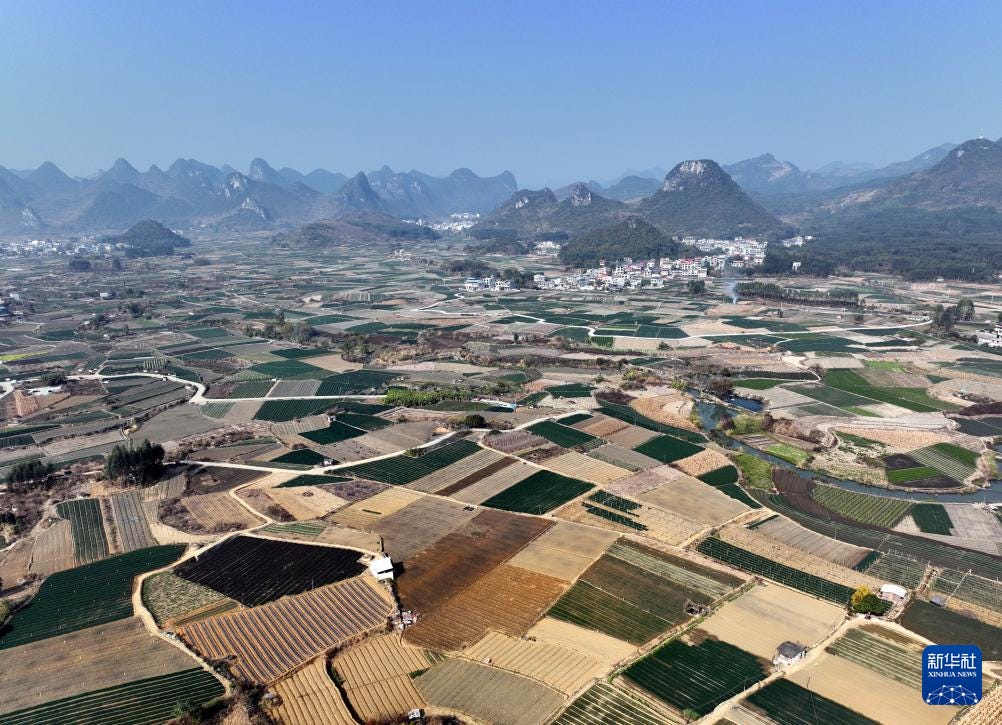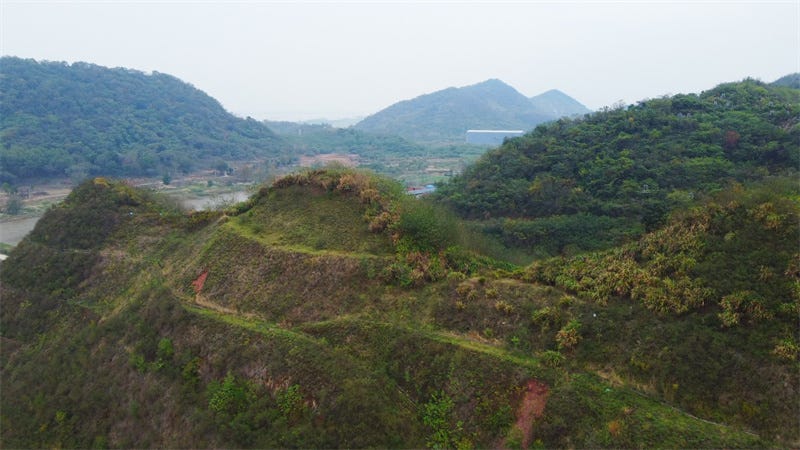The Harvest: This Week in Rural China – Dispatch No. 4 (2 January 2025)
Exploring Tourism, Ecological Transformation, and Financial Innovation, This Week in Rural China.

Welcome to this week’s edition of The Harvest, the weekly dispatch from This Week in Rural China. As we move into 2025, we continue to witness the dynamic transformations unfolding in rural China. This week, we delve into the anticipated impact of extended national holidays on rural tourism, the ongoing green transformation of the Yangtze River shoreline in Pengze, and the implementation of flexible retirement policies in rural areas. We also explore the evolving landscape of rural fisheries safety and examine the growing role of financial innovations in advancing rural revitalisation.
Through these stories, we shed light on rural communities’ resilience and diverse strategies for addressing socio-economic, environmental, and infrastructural challenges. As always, we invite your thoughts and reflections. Please share them with us in the comments section or via email at nathan@thisweekinruralchina.com.
We hope this week’s dispatch offers valuable perspectives as we continue to explore rural China’s evolving story.
Holiday Extensions and Rural Tourism: Opportunities and Tensions in China’s Countryside
As China’s Spring Festival and May Day public holidays are extended in 2025, rural areas are preparing for a surge in domestic tourism over the coming months. The government’s decision to extend the Spring Festival from three to eight days and increase May Day from one to two has set the stage for a potentially transformative period for rural tourism. For many rural destinations, this presents an exciting opportunity for economic growth but also underscores the challenges of balancing development with sustainability.
Recent statistics from the 2024 National Day holiday underscore the profound impact of public holidays on tourism, with over 765 million trips generating more than 700 billion yuan in consumption. Provinces such as Jilin and Hainan have capitalised on government incentives, including consumption vouchers, to attract visitors to rural regions. The question now is whether smaller, lesser-known destinations—such as the picturesque village of Wuyuan in Jiangxi, renowned for its ancient architecture and seasonal rapeseed flower fields—can handle the surge it desires without overstretching their limited infrastructure.
This increased focus on rural tourism dovetails with China’s Rural Revitalisation Strategy, which promotes tourism as a crucial component for revitalising local economies. Wuyuan’s integration of agritourism and eco-tourism is a successful example of how rural regions can harness their natural and cultural assets. However, even in such areas, the challenges are considerable: underdeveloped transport infrastructure, insufficient hospitality services, and seasonal overcrowding threaten to limit the benefits of tourism, even for regions with rich cultural and natural resources.
Moreover, the seasonal influx of tourists provides opportunities for temporary employment in sectors like hospitality, crafts, and food services, potentially alleviating some underemployment in rural communities. Nevertheless, this tourism boom also risks commodifying rural life and reducing authentic cultural practices to marketable experiences that may not fully respect or preserve local heritage.
Rural China is poised for a potential tourism surge as the Spring Festival approaches. Will these extended holidays deliver lasting economic benefits or exacerbate existing infrastructural challenges? The coming months will be critical for rural communities, policymakers, and scholars alike, offering valuable insights into the future of tourism in China’s heartlands. This Week in Rural China will inform readers as we move into 2025.
Flexible Retirement and Its Implications for Rural China
On 1 January 2025, China rolled out the Interim Measures for the Implementation of the Flexible Retirement System (实施弹性退休制度暂行办法). This policy will gradually extend the statutory retirement age over the next 15 years. This reform, introduced by the Ministry of Human Resources and Social Security (人力资源社会保障部), the Central Organization Department (中央组织部), and the Ministry of Finance (财政部), aims to address the challenges posed by an ageing population and shrinking labour force while giving workers more flexibility in their retirement choices.
Under this new system, the retirement age for male workers will rise from 60 to 63, while for female workers, it will increase from 50 and 55 to 55 and 58, respectively. The policy introduces a flexible option, allowing workers to voluntarily retire up to three years earlier or delay their retirement for up to three years, provided both the employee and employer agree.
While the policy is aimed at the broader workforce, its implications are particularly pertinent to rural China, where the ageing demographic remains an acute challenge. In many rural areas, elderly workers are often employed in agriculture or local industries that depend on physical labour. With a rapidly ageing population, many of these workers are faced with limited options for retirement, and the flexible retirement system presents an opportunity to prolong their participation in the workforce if they so choose. However, this also raises questions about the sustainability of this model, particularly in regions where work conditions remain physically demanding, and the availability of jobs in non-agricultural sectors is limited.
Introducing a flexible retirement system could significantly affect rural China’s social structure and economy. On the one hand, it could help mitigate the economic pressures of an ageing population by encouraging older workers to remain employed longer, supporting local economies struggling with a shrinking and younger-outwardly mobile workforce. On the other hand, this policy raises questions about the accessibility of retirement options in rural areas, where the need for labour-intensive work may keep older generations working longer than is sustainable for their health and well-being.
Moreover, the policy could influence rural migration patterns as younger workers may be more inclined to leave their rural homes for urban opportunities, leaving older populations behind. This could exacerbate the rural labour shortage, highlighting the need for sustainable solutions that integrate older and younger generations into the evolving workforce.
Ultimately, while the flexible retirement system offers greater personal choice and adaptability, its success will depend on how it is implemented in rural areas, where the realities of ageing and economic transition require a nuanced approach. For rural China, this policy will not only reshape retirement norms. Still, it may also serve as a catalyst for a larger conversation about the future of work and ageing in the countryside.
Reevaluating Rural Fisheries Safety: Implications for Policy and Rural China
In late December 2024, Han Jun, Minister of Agriculture and Rural Affairs (农业农村部), conducted a significant inspection tour in Liaoning province to address the persistent challenges facing marine fisheries safety. The visit, which spanned December 30–31, sought to highlight key developments in fisheries management and underscore the Ministry’s broader policy objectives. Like others recently issued by the Ministry, the press release reveals a straightforward narrative: a push for enhanced safety in marine fisheries, leveraging both technological advancements and strengthened regulatory frameworks.
The central theme of the Ministry’s communication is the ongoing effort to integrate digital technologies into rural industries to improve safety and efficiency. In Liaoning, where frequent marine accidents have raised concerns about the sustainability of local fisheries, the Ministry has focused on deploying the BeiDou Navigation Satellite System (北斗卫星导航系统). This Chinese satellite navigation system is essential for real-time vessel tracking, risk assessment, and emergency response. However, the press release is conspicuously vague on the actual impact of these technologies on safety outcomes, raising questions about the Ministry’s emphasis on tech as a panacea.
Furthermore, Han Jun’s remarks highlight a key policy shift towards decentralised, locality-driven safety oversight. The Ministry’s call for “strengthening regulatory responsibility” within local government structures appears to reflect broader national strategies for rural governance, such as decentralising administrative oversight to achieve more targeted interventions. Yet, there are no clear indicators of how these measures will be evaluated or held accountable at the grassroots level. While the release offers numerous anecdotes of how local fishing ports like Dalian Bay have adopted digital tools, there is little discussion of the actual capacity of these local governments to implement such sweeping reforms consistently across China’s diverse coastal regions.
Moreover, the Ministry’s focus on “green” and sustainable fisheries technologies, including promoting eco-friendly aquaculture practices and seafood processing, starkly contrasts the ongoing environmental challenges facing rural areas. While the Ministry’s narrative suggests that these efforts are aligned with China’s broader ecological goals, there is no mention of how these initiatives align with existing rural revitalisation programs or address the entrenched socio-economic realities of coastal communities. The press release implies that technological solutions—such as the BeiDou system and digital monitoring—are sufficient for achieving safety and sustainability. Yet, this glosses over deeper structural issues, such as the lack of adequate infrastructure in many fishing communities, which remains a significant barrier to fully realising these digital interventions.
The Ministry’s messaging reveals a tension between ambitious top-down directives and the on-the-ground realities of rural governance. The emphasis on “digitalisation” and “modernisation” in a sector traditionally dependent on manual and often precarious labour raises questions about whether these technological solutions are fully integrated into rural livelihoods or risk deepening existing divides. Furthermore, the lack of concrete data or specific policy targets in the Ministry’s statement invites scrutiny. While the government promotes initiatives such as installing BeiDou systems on vessels and modernising fishing ports, there is little indication of how success will be measured or the full scope of investment involved.
In short, this recent press release exemplifies broader trends in China’s rural policy-making, where technology deployment, the decentralisation of regulatory oversight, and the rhetoric of green development intersect. However, the gap between policy ambition and implementation remains significant, and rural China watchers will need to critically assess both the feasibility and the impact of such initiatives in the coming years. While these policies may potentially transform marine fisheries, they also risk overlooking the local socio-economic dynamics that ultimately shape the outcomes of rural development initiatives. Thus, the Ministry’s focus on safety and sustainability should be considered part of an ongoing experiment in rural governance, where real-world impacts may differ from the state’s idealised narratives.
Ecological Revival Along the Yangtze: Pengze’s Green Transformation
The transformation of the Yangtze River’s shoreline in Pengze County, Jiangxi, exemplifies the power of large-scale ecological restoration. Once scarred by over-exploitation and mining, the area has undergone a remarkable metamorphosis. Notably, the restoration of Guanyin Mountain, a former mining wasteland, highlights the region’s dedication to revitalising its landscapes. With soil stabilisation and afforestation strategies, this once-barren area has regained its verdant vitality, contributing to environmental and public health improvements.
Since 2018, Pengze’s efforts to reclaim its environment have centred around the dual goals of disaster mitigation and ecological restoration. The rehabilitation of Guanyin Mountain and the adjacent Lion Mountain, also an abandoned quarry, illustrates a broader initiative to secure the “most beautiful shoreline” of the Yangtze. Once plagued by erosion and air pollution, these areas are now vibrant hubs for community engagement, offering green spaces for recreation and leisure.
Furthermore, the success of these projects is not just environmental; they reflect the intersection of ecological sustainability and local economic development. By blending landscape rehabilitation with tourism, Pengze has created a model where ecological restoration fosters environmental health and community prosperity. This transformation invites a larger conversation about the role of rural areas in China’s broader environmental and socio-economic strategies, highlighting the potential for green development as a cornerstone of rural revitalisation.
This example of ecological restoration along the Yangtze serves as a microcosm of China’s efforts to balance development with sustainability, an essential narrative for the future of rural China.
Financial Innovations for Rural Revitalisation: Assessing China’s Strategic Shift in Agricultural Finance
In December 2024, the People’s Bank of China (中国人民银行), the Ministry of Agriculture and Rural Affairs (农业农村部, MARA), and the China Banking and Insurance Regulatory Commission (中国银行保险监督管理委员会, CBIRC) convened a pivotal meeting to advance financial services for rural revitalisation, reinforcing the centrality of agriculture in China’s economic future. This meeting forms part of an ongoing effort to implement the policies outlined at the 20th Party Congress, where rural development and ecological sustainability were highlighted as key priorities.
The strategic thrust of the meeting lies in enhancing financial infrastructure within rural areas, notably through tailored credit mechanisms, such as agricultural facility loans and diversified financial products that cater specifically to the farming sector. The integration of agrarian insurance into these frameworks, including grain insurance and precision farming policies, underscores a shift towards risk mitigation in rural economies. The expansion of credit accessibility, primarily via non-collateral loans, reflects broader governmental efforts to encourage entrepreneurship and ensure that farmers, particularly those in marginalised communities, can access capital to invest in productivity improvements.
From an academic perspective, this initiative invites a critical examination of China’s approach to financialisation in rural development. The emphasis on integrated rural finance systems—through digital platforms, improved data sharing, and enhanced regulatory oversight—raises questions about the scalability and sustainability of these measures. Moreover, this policy could further entrench the state’s role in rural economies, warranting an analysis of the balance between state intervention and market forces in shaping rural livelihoods. In particular, promoting green and low-carbon agriculture and technological innovations offers opportunities to explore the tensions between environmental sustainability and economic productivity within rural revitalisation.
The outcome of this policy will likely have significant implications for the future of China’s rural economy. Researchers will need to monitor its implementation closely, assessing the effectiveness of financial instruments in supporting rural enterprises and their ability to address long-term challenges such as agricultural labour shortages, income disparity, and environmental degradation.
Between Mountains and Waters - Photo of the Week for 2 January 2025

Jue Mountain Village, located in the core demonstration area of the 10,000-acre Xiangcong industry in Liuzhou’s Liujiang District, has cultivated a thriving fragrant spring onion industry. Covering 8,000 acres, over 1,000 households in the village are engaged in onion farming. In addition to onions, villagers employ crop rotation and intercropping techniques to grow over ten different vegetables, including ginger, beans, cucumbers, and greens, ensuring a year-round harvest. This multi-cropping approach supports a stable supply for local markets, contributing to food security and sustainable farming practices. Under the regional Party's and government's continuous guidance, the community is steadily building a prosperous and beautiful village with a thriving economy and wealth for its farmers.









This is such great content, thank you a million times. The financial aspect of rural revitalization is going to be really interesting to follow. I recently came across this piece of information which maybe you have also heard of: MARA is joining with the FAO for a two-year comparative study on domestic ag support policies for transforming food production systems (https://www.fao.org/china/news/detail-events/en/c/1727446/)